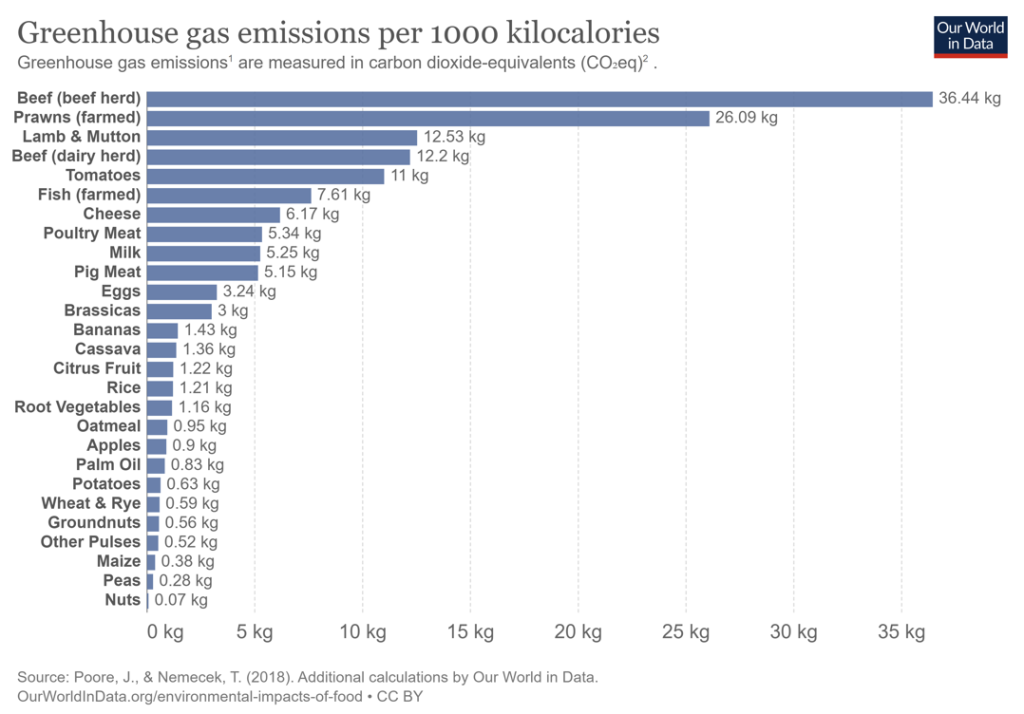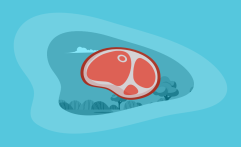What Is the Carbon Footprint of Potatoes? A Life-Cycle Analysis
Impactful Ninja is reader-supported. When you buy through links on our site, we may earn an affiliate commission.
Learn more
Learn more
.
Hey fellow impactful ninja ? You may have noticed that Impactful Ninja is all about providing helpful information to make a positive impact on the world and society. And that we love to link back to where we found all the information for each of our posts. Most of these links are informational-based for you to check out their primary sources with one click. But some of these links are so-called "affiliate links" to products that we recommend. First and foremost, because we believe that they add value to you. For example, when we wrote a post about the environmental impact of long showers, we came across an EPA recommendation to use WaterSense showerheads. So we linked to where you can find them. Or, for many of our posts, we also link to our favorite books on that topic so that you can get a much more holistic overview than one single blog post could provide. And when there is an affiliate program for these products, we sign up for it. For example, as Amazon Associates, we earn from qualifying purchases. First, and most importantly, we still only recommend products that we believe add value for you. When you buy something through one of our affiliate links, we may earn a small commission - but at no additional costs to you. And when you buy something through a link that is not an affiliate link, we won’t receive any commission but we’ll still be happy to have helped you. When we find products that we believe add value to you and the seller has an affiliate program, we sign up for it. When you buy something through one of our affiliate links, we may earn a small commission (at no extra costs to you). And at this point in time, all money is reinvested in sharing the most helpful content with you. This includes all operating costs for running this site and the content creation itself. You may have noticed by the way Impactful Ninja is operated that money is not the driving factor behind it. It is a passion project of mine and I love to share helpful information with you to make a positive impact on the world and society. However, it's a project in that I invest a lot of time and also quite some money. Eventually, my dream is to one day turn this passion project into my full-time job and provide even more helpful information. But that's still a long time to go. Stay impactful,Affiliate Disclosure
Why do we add these product links?
What do these affiliate links mean for you?
What do these affiliate links mean for us?
What does this mean for me personally?
![]()
Roasted, fried, boiled, or mashed, potatoes are one of the more versatile vegetables, which is why they are the second most consumed food in the United States. Americans, on average, eat a potato every day. Potatoes were even the first vegetable to be grown in space! However, much less is shared about the environmental impact, and especially the carbon emissions of potatoes. So we had to ask: What is the carbon footprint of potatoes?
Potatoes have a carbon footprint of 0.12 kg (0.27 lb) of CO2e per pound of produce, which is very low for crops. Over 60% of the carbon footprint is due to the resources used while growing potatoes. Choosing organic, fresh, unpackaged potatoes is the most sustainable way to purchase this produce.
In this article, we’ll walk you through the overall carbon emissions of the life-cycle of potatoes. From growing and packaging, to transportation and end-of-life practices, you will learn how this vegetable affects the planet and discover some ways to reduce and offset the footprint.
Here’s How We Assessed the Carbon Footprint of Potatoes
The carbon footprint is one of the ways we measure the effects of our human-induced global climate change. It primarily focuses on the greenhouse gas (GHG) emissions associated with consumption, but also includes other emissions such as methane (CH4), nitrous oxide, and chlorofluorocarbons, and is generally expressed in carbon dioxide equivalents (CO2e).
“Carbon footprint: the amount of greenhouse gases and specifically carbon dioxide emitted by something (such as a person’s activities or a product’s manufacture and transport) during a given period”
Merriam Webster
Basically, it is the amount of carbon emitted by you as an individual or an organization providing you with goods and services – including potatoes:
- This includes GHG emissions from producing the products that we use and foods that we eat (e.g., power plants, factories or farms, and landfills)
- GHG emissions from fuel that we burn directly or indirectly (e.g., logistics and transportation, cooling or heating facilities),
- as well as the GHG emissions attributed to how we consume these products and foods.
To understand the carbon footprint of potatoes, we must assess its life-cycle and each stage’s sustainability. This life-cycle assessment (LCA) is a method to evaluate the environmental impacts of products and materials.
Here’s the Overall Carbon Footprint of Potatoes
The overall carbon footprint of potatoes is 0.12 kg (0.27 lb) of CO2e per pound of potatoes, which is very low. Potatoes produce less than half of the carbon emissions of lettuce, and almost a quarter less carbon emissions than cucumber.
| The carbon footprint of potatoes | 0.12 kg (0.27 lb) of CO2e per pound of potatoes |
So, let’s have a look at each stage of the LCA of potatoes!
| The life-cycle stages of potatoes | Each stage’s carbon footprint |
| Growing of potatoes | The carbon footprint of growing potatoes is 0.08 kg (0.17 lb) of CO2e per pound of produce. This amounts to over 60% of the overall carbon footprint. The growing period of any crop tends to be resource-intensive, due to the land, water, and pesticide usage. Potatoes use very little water and very few pesticides so they have a relatively low growth carbon footprint. |
| Harvesting, processing, and packaging of potatoes | The carbon footprint of harvesting, processing, and packaging potatoes is 0-0.09 kg (0-0.2 lb) of CO2e per pound of produce. This amounts to 26.85% of the overall carbon footprint. Since only 30% of potatoes are eaten fresh in the US, these stages have a significant impact on the overall carbon footprint. |
| Transporting of potatoes | The carbon footprint of transporting potatoes is 0-0.04 kg (0-0.1 lb) of CO2e per pound of produce. This amounts to 11.15% of the overall carbon footprint. Potatoes are grown widely across the states, which means tha local-grown produce is easier to find. Local crops are better for the environment, and lower the carbon footprint of this plant. |
| End-of-life of potatoes | The carbon footprint of the end-of-life of potatoes is largely impacted by the amount of food wasted. Unfortunately, potatoes are one of the most wasted foods, with 3 billion pounds of potatoes thrown away every year. This increases the carbon footprint. Any packaging used is bad for the environment, but lengthens the shelf-life, leading to less food waste. This can be offset by proper storing methods, which can increase shelf-life without the need of plastic packaging. |
These four stages can be broken down in more detail to understand why the carbon footprint of potatoes is low in comparison to other vegetables.
What Is the Carbon Footprint of Growing Potatoes
The carbon footprint of growing potatoes is 0.08 kg (0.17 lb) of CO2e per pound of produce. This amounts to over 60% of the overall carbon footprint. The growing period of any crop tends to be resource-intensive, due to the land, water, and pesticide usage. Potatoes use very little water and very few pesticides so they have a relatively low growth carbon footprint.
Potatoes are grown underground, and do not require a lot of resources. Fewer resources needed in the agricultural process lead to a far smaller carbon footprint.
Which factors impact the carbon footprint of growing potatoes?
- How do potatoes grow: Potatoes are tubers that grow underground. Around 20 tubers can be grown from one potato plant. Underground vegetables generally require far less resources than vegetables grown above ground in fields or energy-intensive greenhouses.
- What is the growth duration of potatoes: On average, potatoes take 3-4 months to reach maturity. This is an above-average growing time, similar to that of peppers. A longer than average growing time increases the carbon footprint, due to the extra resources needed.
- What is the land usage of potatoes: According to the UN, potatoes use ‘less land per kilogram of production than most other foods’. They have a high yield of 40-70 tonnes per hectare on commercial farms. This means the carbon footprint is lower than low-yield vegetables, because less resources are needed to grow more crops.
- What is the water usage of potatoes: Potatoes were found to produce more food energy per cubic meter of water used, than any other major crop, in a study by the UN. They are also seven times more water efficient than cereals. This lowers the carbon footprint of potatoes.
- What is the pesticide and fertilizer usage of potatoes: The Environmental Working Group has not identified any concerns about potatoes, and almost 74% of potato samples were found to contain no pesticides. Since pesticide usage produces carbon emissions through manufacturing, transportation, and application to crops, the fact that potatoes are treated with minimal pesticides has a positive impact on the environment.
In short, the growing process of any vegetable usually is the most carbon-intensive stage, and this is true with potatoes. However, due to the low water, land, and pesticide use, potatoes have a low carbon footprint.
What Is the Carbon Footprint of Harvesting, Processing, and Packaging Potatoes
The carbon footprint of harvesting, processing, and packaging potatoes is 0-0.09 kg (0-0.2 lb) of CO2e per pound of produce. This amounts to 26.85% of the overall carbon footprint. Since only 30% of potatoes are eaten fresh in the US, these stages have a significant impact on the overall carbon footprint.
Potatoes are harvested by carbon-intensive machines, and are processed into many different dishes, such as fries, chips, and feed for livestock. The resources needed for these processes contribute to the carbon emissions of potatoes.
Which factors impact the carbon footprint of harvesting, processing, and packaging potatoes?
- How are potatoes harvested: Potatoes are generally harvested by machine, which can harvest up to twelve rows of crops at a time, and automatically collect them. This is more labor-efficient than hand-harvesting, however these tractors have negative impacts on soil health and release a lot of carbon emissions, increasing the carbon footprint of potatoes.
- How are potatoes processed: Around 60% of potatoes are processed rather than eaten fresh. Products like crisps, fries, ready-made mash, roast potatoes and other pre-packaged meals include processed potatoes. These often start with size sorting on a vibrating machine, followed by a wash. Then, depending on the product, they can be peeled, chopped, bleached, fried, shock-freezed, and seasoned. This processing requires a lot of electricity and resources, increasing the carbon footprint. However, these processed products could lead to less waste, due to extended shelf-life, which would decrease the carbon footprint of potatoes.
- How are potatoes packaged: Potatoes can either be transported loose in barrels, or crates, or packaged in hessian bags, poly-mesh, polyethylene bags, or kraft paper. These are generally quite eco-friendly materials, however poly-mesh, and polyethylene are plastics which increase the carbon footprint. Choosing plastic-free potatoes is a more sustainable choice.
In short, the processing and harvesting stages are relatively carbon-intensive. Buy packaging-free potatoes to lower the carbon footprint of this crop.
What Is the Carbon Footprint of Transporting Potatoes
The carbon footprint of transporting potatoes is 0-0.04 kg (0-0.1 lb) of CO2e per pound of produce. This amounts to 11.15% of the overall carbon footprint. Potatoes are grown widely across the states, which means tha local-grown produce is easier to find. Local crops are better for the environment, and lower the carbon footprint of this plant.
Potatoes can grow anywhere in the United States, and so commercial farming is spread wide across the country. Processed potatoes are often imported from across the world, so aim to buy local, fresh potatoes, as they have a much smaller carbon footprint.
Which factors impact the carbon footprint of transporting potatoes?
- Where are potatoes grown: Potatoes are grown in 30 states, with Idaho growing more potatoes than any other state. Washington, North Dakota, Wisconsin, and Colorado also produce a lot of potatoes. Potatoes can adapt to being grown across the country, meaning that locally grown potatoes can be relatively simple to find. However, imported potatoes are also increasing year by year. Canada supplies all fresh potato imports, but processed potatoes are imported from Mexico, the Netherlands, Germany, and Canada. Shipping across the world increases the carbon footprint, so aim to buy local produce.
- How are potatoes transported: Potatoes are transported either by road, rail, air, or ship. Like most fresh produce, they require constant refrigeration in the transportation process. Unfortunately, refrigerated vehicles can emit up to 29 times more potentially carcinogenic particulate matter and six times more nitrogen oxides than far larger, modern diesel truck engines. If potatoes are bought from local farms, the carbon footprint is decreased.
In short, locally grown potatoes produce far fewer carbon emissions, so aim to find local farms, or even grow your own, as potatoes can be grown in any U.S. state!
What Is the Carbon Footprint of the End-of-Life of Potatoes
The carbon footprint of the end-of-life of potatoes is largely impacted by the amount of food wasted. Unfortunately, potatoes are one of the most wasted foods, with 3 billion pounds of potatoes thrown away every year. This increases the carbon footprint. Any packaging used is bad for the environment, but lengthens the shelf-life, leading to less food waste. This can be offset by proper storing methods, which can increase shelf-life without the need of plastic packaging.
Potatoes have a very long shelf-life, and can be stored for months, in the right conditions. However, nearly half of all fresh potatoes are discarded. Be conscious of your consumption to reduce this waste.
Which factors impact the carbon footprint of the end-of-life of potatoes?
- How are potatoes disposed of: 49% of potatoes are discarded whole, meaning that there are over 359,000 tonnes of avoidable potato waste a year. Potatoes are completely compostable but often end up in landfill, which is a big problem for the environment. Potatoes can actually last for months, but consumers are often put off by premature sprouting, caused by improper storage. Keep potatoes in a paper or cardboard bag in a cool, dark pantry to increase their shelf-life and reduce the likelihood of waste.
- How is the packaging of potatoes disposed of: Plastic packaging can be difficult to recycle. However, many of the polyethylene bags used for packaging are recyclable, as long as the polyethylene is not bonded with other plastics. This is because polyethylene is generally only recycled to make like-for-like products. Still, it is much more sustainable to buy loose produce. A lot of plastic that we recycle ends up on the other side of the world, causing a threat to developing countries. So, it is not as good for the environment as we may imagine. Since processed potatoes are rarely sold loose, this increases the carbon footprint.
In short, there is a great deal of potato waste, which increases the carbon footprint of this product. They are easy to forget in the back of your cupboard, so make sure to be aware of reducing waste, and not buying too many potatoes, that may go off before you have a chance to consume them. Aim to buy loose potatoes to reduce plastic waste, or potatoes in recyclable materials like paper bags or cardboard boxes.
How Does the Carbon Footprint of Potatoes Compare to Other Types of Food
Potatoes have a very low carbon footprint compared to other vegetables. Additionally, vegetables tend to produce far fewer carbon emissions than other types of food, making potatoes a highly sustainable snack choice!
Let’s see how potatoes compare with other vegetables.
How Does the Carbon Footprint of Potatoes Compare to Other Types of Vegetables
In comparison to other vegetables, the carbon footprint of potatoes is low. For example, cucumbers produce more than 8 times the carbon emissions of potatoes. Salad vegetables need more resources to grow, making their carbon footprint far higher than root vegetables.
So, potatoes are one of the more sustainable vegetables, but how do they compare to other types of food?
How Does the Carbon Footprint of Potatoes Compare to Other Types of Food in General
Root vegetables have a very low carbon footprint in comparison to other types of food. Potatoes produce around 88 times fewer greenhouse gas emissions than beef.
When it comes to greenhouse gas emissions (GHG), foods are often compared in terms of emissions per 1,000 kilocalories (as opposed to their weight in lbs or kg).

Additionally, since potatoes are low in calories, a far greater amount of produce is needed to equal 1,000 kilocalories.
- To eat 1,000 kilocalories, you would need to consume 24.4 servings, which is around 49 full potatoes or 46 ounces.
- In comparison to beef you would only need 4.6 servings to eat 1,000 kilocalories, or 16 ounces.
- Comparatively, vegetables can have a high carbon footprint per kilocalorie, but are enormously less calorific than animal-based food.
- More calorific plant-based foods, such as pulses and nuts, have a miniscule carbon footprint in comparison to animal-based proteins. A single portion of beef amounts to around three portions of carrots, in terms of calories.
- This means that per portion, you will be consuming fewer calories, and so the carbon footprint will not be as large as this graph suggests.
Even though the carbon emissions for potatoes are low in comparison to other types of food, try to be mindful of the ways you can lessen your environmental impact when you purchase them.
How Can You Reduce and Offset Your Personal Carbon Footprint
All of the food you eat will have some form of carbon footprint, even when you buy foods with relatively low CO2e, such as potatoes. However, there are ways to offset and reduce your personal carbon footprint.
There are a few easy techniques to buy more eco-friendly potatoes, and you can also find ways to offset the carbon footprint after your purchase.
How Can You Reduce Your Carbon Footprint When Shopping for Potatoes
When shopping for potatoes, consider these ways to lessen your impact on the environment.
- Shop locally and seasonally: Potatoes are in prime season from June to October. Buying from local farms reduces the carbon emissions produced and makes it a much more sustainable choice. If you are near a local, small-scale farm, which harvests by hand, your purchase will be even better for the environment.
- Choose organic: Organic potatoes produce a much lower carbon footprint than non-organic vegetables, due to the lack of pesticide production, distribution, and the overall higher health of soil for crops, insects, and animals.
- Buy plastic-free: Avoid pre-processed and packaged potatoes, and instead opt for whole, loose produce. This will decrease the overall carbon footprint of your purchase massively.
Taking these actions are a great way to lessen your own carbon footprint, but there are also ways to offset the impact of consuming potatoes as well.
How Can You Offset Your Personal Carbon Footprint
Carbon offsets are reductions in carbon emissions that are used to compensate for carbon emissions occurring elsewhere – for example for the carbon emissions that are associated with potatoes. They are measured in tons of CO2 equivalents and are bought and sold through international brokers, online retailers, and trading platforms on what is known as the global carbon offset market.
“Carbon Offset: a way for a company or person to reduce the level of carbon dioxide for which they are responsible by paying money to a company that works to reduce the total amount produced in the world, for example by planting trees”
Oxford Dictionary
In terms of potatoes – and indeed all food types – there will always be a carbon footprint, because of the resources it takes to get your food from farms to the place where you’ll eventually eat them. And while there are ways to reduce your carbon footprint when shopping for potatoes, carbon offsets would be a way to reduce your CO2e emissions all the way down to net zero (or even to become climate positive).
However, when you purchase carbon offsets, it’s important that they actually make a difference in offsetting (aka reducing) total carbon emissions. To achieve that, the following are key criteria:
- Carbon offset projects have to be effective (different projects have different effectiveness rates)
- Carbon offset projects have to be additional
- Carbon offset projects have to be permanent
- The claims from carbon offset projects have to be verifiable
To find the best carbon offsets for you personally, check out our full guide on the best carbon offsets for individuals, where you’ll also learn more about how these carbon offset projects work, what their respective offsetting costs are, and what your best way would be to offset your own carbon emissions.
Final Thoughts
Potatoes have a low carbon footprint when compared with other vegetables and a very low carbon footprint when compared with other foods. However, you can try to reduce your carbon footprint even further by eating organic, reducing food and plastic waste, and purchasing local, seasonal produce. When you do enjoy potatoes, think about whether you can offset the carbon emissions created, to make this healthy snack a more sustainable option!
Stay impactful,

Sources
- Maine Potatoes: How Popular are Potatoes?
- Medium: The Potato was the First Food Grown in the Outer Space
- Britannica: Carbon footprint
- Science Direct: Life-cycle assessment (LCA)
- MIT SMR: Strategic Sustainability Uses of Life-Cycle Analysis
- Carbon Cloud: Potatoes
- Impactful Ninja: What Is the Carbon Footprint of Lettuce
- Impactful Ninja: What Is the Carbon Footprint of Cucumber
- The Guardian: Nearly half of all fresh potatoes thrown away daily by UK households
- CIP International Potato Centre: How Potato Grows
- Environment: Are Greenhouses Bad for the Environment?
- Impactful Ninja: What Is the Carbon Footprint of Bell Peppers
- Potatoes USA: Potato Sustainability
- WikiFarmer: Potato Harvest Yield & Storage
- CIP International Potato Centre: Potato Facts and Figures
- Environmental Working Group: Potatoes
- The 2020 European Union report on pesticide residues in food: Potatoes
- Potato Pro: USA Statistics
- University of California, Statewide Integrated Pest Management Program: Agriculture: Potato Pest Management Guidelines
- Farms Wise: Are Tractors Bad for the Environment?
- Make Food Stay: Potato Processing Steps
- Sustainability Times: Fresh versus frozen: a sustainable choice with a twist
- Cargo Handbook: Potatoes
- Agricultural Marketing Resource Centre: Potatoes
- Potatoes USA: U.S. Potato Imports Continue to Grow
- Transport Information Service: Potatoes
- The ACR Journal: Refrigerated vehicles contribute to thousands of deaths and costs across EU
- WRAP: The Food We Waste
- World Wildlife Fund: Fight climate change by preventing food waste
- Food 52: How to Store Potatoes So They Last for Months (Yes, Months)
- Let’s Recycle: Supermarkets to take back plastic film in-store
- Sesotec: Recycling more packaging –potential for PE and PP
- Live Science: The Plastic We ‘Recycle’ Is Actually Horrible for the Environment
- Impactful Ninja: What Is the Carbon Footprint of Tomatoes
- Impactful Ninja: What Is the Carbon Footprint of Salad Mix
- Impactful Ninja: What Is the Carbon Footprint of Broccoli
- Impactful Ninja: What Is the Carbon Footprint of Celery
- Our World in Data: Greenhouse Gas Emissions per 1000 kilocalories
- My Fitness Pal: Potato
- Healthline: Beef 101: Nutrition Facts and Health Effects
- Plantura Magazine: Harvesting potatoes: how & when to dig potatoes up
- Columbia Climate School: Is Organic Food Really Better for the Environment?
- Impactful Ninja: Best Carbon Offsets for Individuals




